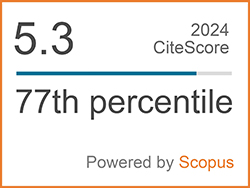Performance and Pathway of 4-Chloroaniline Degradation: A Comparative Study of Electro-Peroxone, Ozonation, and Electrolysis Processes
Abstract
Keywords
[1] A. S. Vangnai and W. Petchkroh, “Biodegradation of 4-chloroaniline by bacteria enriched from soil,” FEMS Microbiology Letters, vol. 268, no. 2, pp. 209–216, 2007, doi: 10.1111/j.1574-6968.2006.00579.x.
[2] S. Jenjaiwit, N. Supanchaiyamat, A. J. Hunt, Y. Ngernyen, T. Ratpukdi, and S. Siripattanakul-Ratpukdi, “Removal of triclocarban from treated wastewater using cell-immobilized biochar as a sustainable water treatment technology,” Journal of Cleaner Production, vol. 320, 2021, Art. no. 128919, doi: 10.1016/j.jclepro.2021. 128919.
[3] I. Hussain, Y. Zhang, S. Huang, and X. Du, “Degradation of p-chloroaniline by persulfate activated with zero-valent iron,” Chemical Engineering Journal, vol. 203, pp. 269–276, 2012, doi: 10.1016/j.cej.2012.06.120.
[4] J. Sarasa, S. Cortés, P. Ormad, R. Gracia, and J. L. Ovelleiro, “Study of the aromatic by-products formed from ozonation of anilines in aqueous solution,” Water Research, vol. 36, no. 12, pp. 3035–3044, 2002, doi: 10.1016/S0043-1354(02) 00003-9.
[5] International Agency for Research on Cancer, “Para-Chloroaniline,” IARC Monographs on the evaluation of Carcinogenic Risks to Humans, vol. 57, pp. 305–321, 1993.
[6] I. Nitoi, P. Oancea, I. Cristea, L. Constsntin, and G. Nechifor, “Kinetics and mechanism of chlorinated aniline degradation by TiO2 photocatalysis,” Journal of Photochemistry and Photobioligy A: Chemitry, vol. 298, pp. 17–23, 2015, doi: 10.1016/j.jphotochem.2014.10.005.
[7] J. Kong, Y. Lu, Y. Ren, Z. Chen, and M. Chen, “The virus removal in UV irradiation, ozonation and chlorination,” Water Cycle, vol. 2, pp. 23–31, 2021, doi: 10.1016/j.watcyc.2021.05.001.
[8] C. Wei, F. Zhang, Y. Hu, C. Feng, and H. Wu, “Ozonation in water treatment: The generation, basic properties of ozone and its practical application,” Reviews in Chemical Engineering, vol. 33, no. 1, pp. 49–89, 2016, doi: 10.1515/revce-2016-0008.
[9] W. Q. Guo, Q. L. Wu, X. J. Zhou, H. O. Cao, J. S. Du, R. L. Yin, and N. Q. Ren, “Enhanced amoxicillin treatment using electro-peroxone process: Key factors and degradation mechanism,” Royal Society of Chemistry, vol. 5, pp. 52695–52702, 2015, doi: 10.1039/C5RA07951A.
[10] S. Yu, Z. Xie, X. Wu, Y. Zheng, Y. Shi, Z. Xiong, P. Zhou, Y. Liu, C. He, Z. Pan, K. Wang, and B. Lai, “Review of advanced oxidation processes for treating hospital sewage to achieve decontamination and disinfection,” Chinese Chemical Letters, vol. 35, 2024, Art. no. 108714, doi: 10.1016/j.cclet.2023.108714.
[11] A. Shokri and B. Nasernejad, “Investigation of spent caustic effluent treatment by electro-peroxone process; Cost evaluation and kinetic studies,” Journal of Industrial and Engineering Chemistry, vol. 129, pp. 170–179, 2024, doi: 10.1016/j.jiec.2023.08.030.
[12] D. Amado-Piña, G. Roa-Morales, M. Molina-Mendieta, P. Balderas-Hernandez, R. Romero, C. E. Barrera Diaz, and R. Natividad, “E-peroxone Process of a Chlorinated Compound: Oxidant Species, Degradation Pathway and Phytotoxicity,” Journal of Environmental Chemical Engineering, vol. 10, 2022, Art. no. 108148, doi: 10.1016/j.jece.2022.108148.
[13] Y. Y. Lim, A. Miskon, and A. M. A. Zaidi, “CuZn complex used in electrical biosensors for drug delivery systems,” Materials, vol. 15, no. 21, p. 7672, 2022, doi: 10.3390/ma15217672.
[14] S. Jenjaiwit, S. Siripattanakul-Ratpukdi, E. Khan, J. Prasopsuk, and T. Ratpukdi, “Electro-peroxone process for triclocarban and triclosan removal and reclaimed water disinfection,” Journal of Water Process Engineering, vol. 67, 2024, Art. no. 106200, doi: 10.1016/j.jwpe.2024. 106200.
[15] F. Ghanbari, F. Zirrahi, K. Y. A. Lin, B. Kakavandi, and A. Hassani, “Enhanced electro-peroxone using ultrasound irradiation for the degradation of organic compounds: A comparative study,” Journal of Environmental Chemical Engineering, vol. 8, no. 5, 2020, Art. no. 104167, doi: 10.1016/j.jece.2020.104167.
[16] P. Asaithambi, E. Alemayehu, B. Sajjadi, A. Raman, and A. Aziz, “Electrical energy per order determination for the removal pollutant from industrial wastewater using UV / Fe2+ /H2O2 process : Optimization by response surface methodology,” Water Resources and Industrial, vol. 18, pp. 17–32, 2017, doi: 10.1016/j.wri. 2017.06.002.
[17] A. Shokri and M. S. Fard, “Employing electro-peroxone process for industrial wastewater treatment: A critical review,” Chemical Paper, vol. 76, no. 9, pp. 5341–5367, 2022, doi: 10.1007/s11696-022-02269-y.
[18] X. Li, Y. Wang, J. Zhao, H. Wang, B. Wang, J. Huang, S. Deng, “Electro-peroxone treatment of the antidepressant venlafaxine : Operational parameters and mechanism,” Journal of Hazardous Material, vol. 300, pp. 298–306, 2015, doi: 10.1016/j.jhazmat.2015.07.004.
[19] M. R. K. Kashani, R. Kiani, A. Hassani, A. Kadier, S. Madihi-Bidgoli, K. Y. A. Lin, and F. Ghanbari, “Electro-peroxone application for ciprofloxacin degradation in aqueous solution using sacrificial iron anode: A new hybrid process,” Seperation and Purification Technology, vol. 292, 2022, Art. no. 121026, doi: 10.1016/ j.seppur.2022.121026.
[20] Z. Dong, J. Yao, Y. Tang, Y. Jia, Y. Zhang, and H.Liu, “Process optimization of ozone-resistant compounds degradation in electro-peroxone process: From removal performance to mechanism investigation,” Journal of Water Process Engineering, vol. 59, 2024, Art. no. 104988, doi: 10.1016/j.jwpe.2024.104988.
[21] K. Xu and U. V. Gunten, “The Mn(VII)–H2O2 oxidation process: Abatement of electron-deficient N-containing organic compounds,” Chemical Engineering Journal, vol. 481, 2024, Art. no. 148630, doi: 10.1016/j.cej.2024.148630.
[22] H. Wang, S. Yuan, J. Zhan, Y. Wang, G. Yu, S. Deng, J. Huang, and B. Wang “Mechanisms of enhanced total organic carbon elimination from oxalic acid solutions by electro-peroxone process,” Water Research, vol. 80, pp. 20–29, 2015, doi: 10.1016/j.watres.2015.05.024.
[23] O. M. Cornejo and J. L. Nava, “Mineralization of the antibiotic levofloxacin by the electro-peroxone process using a filter-press flow cell with a 3D air-diffusion electrode,” Seperation and Purification Technology, vol. 254, Art. no. 117661, 2021, doi: 10.1016/j.seppur.2020.117661.
[24] P. Kiattisaksiri, N. Petmark, and T. Ratpukdi, “Combination of coagulation and VUV+H2O2 for the treatment of color and organic matter in treated effluent wastewater from a sugar factory,” Appl. Sci. Eng. Prog. vol. 16, no. 4, p. 6192, 2023, doi: 10.14416/j.asep.2022.08.002.
[25] L. Carena, D. Vione, M. Minella, S. Canonica, and U. Schönenberger, “Inhibition by phenolic antioxidants of the degradation of aromatic amines and sulfadiazine by the carbonate radical (CO3•−),” Water Research, vol. 209, 2022, doi: 10.1016/j.watres.2021.117867.
[26] J. M. Shen, Z. L. Chen, Z. Z. Xu, X. Y. Li, B. B. Xu, and F. Qi, “Kinetics and mechanism of degradation of p-chloronitrobenzene in water by ozonation,” Journal of Hazardous Material, vol. 152, no. 3, pp. 1325–1331, 2008, doi: 10.1016/ j.jhazmat.2007.08.009.
[27] UNEP Publications. “SIDS initial assessment report for SIAM 15, 1-Chloro-4-Nitrobenzene.” hpvchemicals.oecd.org. https://hpvchemicals.oecd.org/UI/handler.axd?id=ad5cafea-2e80-4360-9aba-9056532403f0 (accessed Feb. 1, 2025).DOI: 10.14416/j.asep.2025.05.009
Refbacks
- There are currently no refbacks.
 Applied Science and Engineering Progress
Applied Science and Engineering Progress







